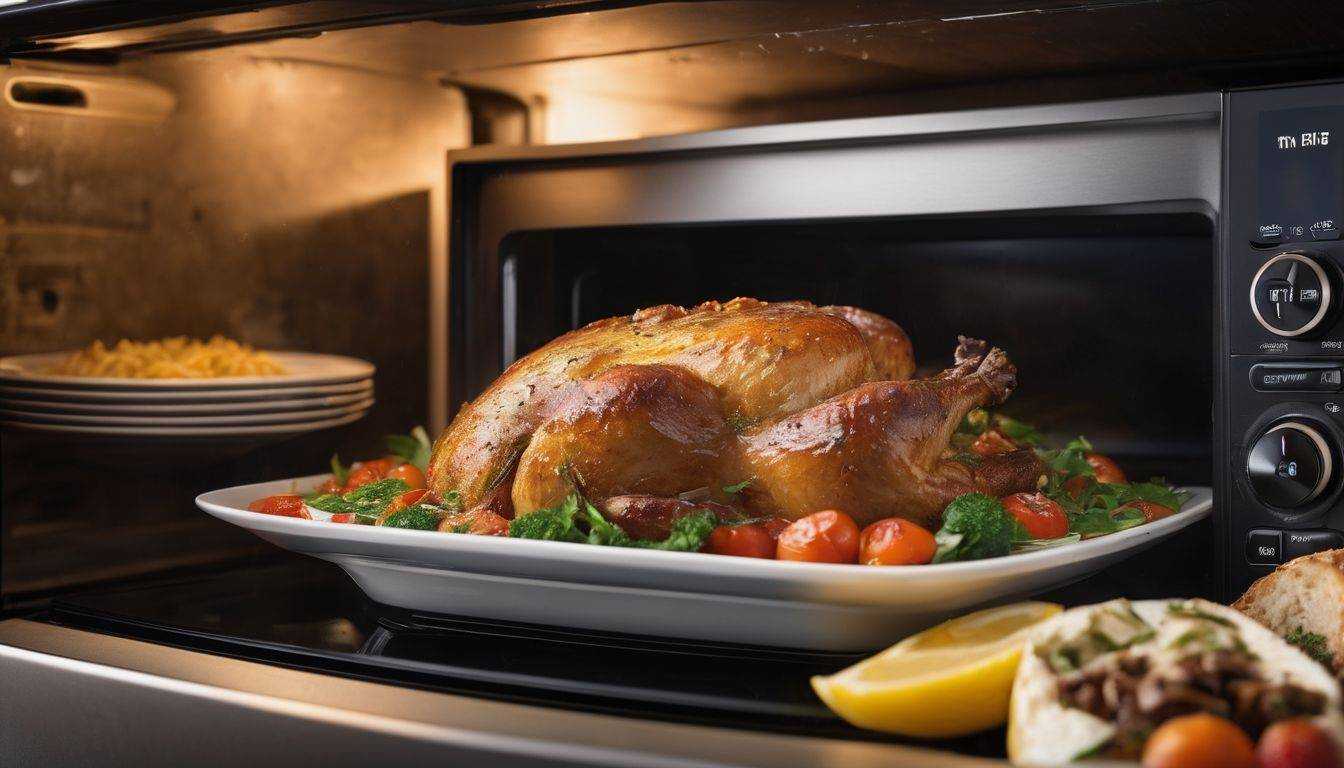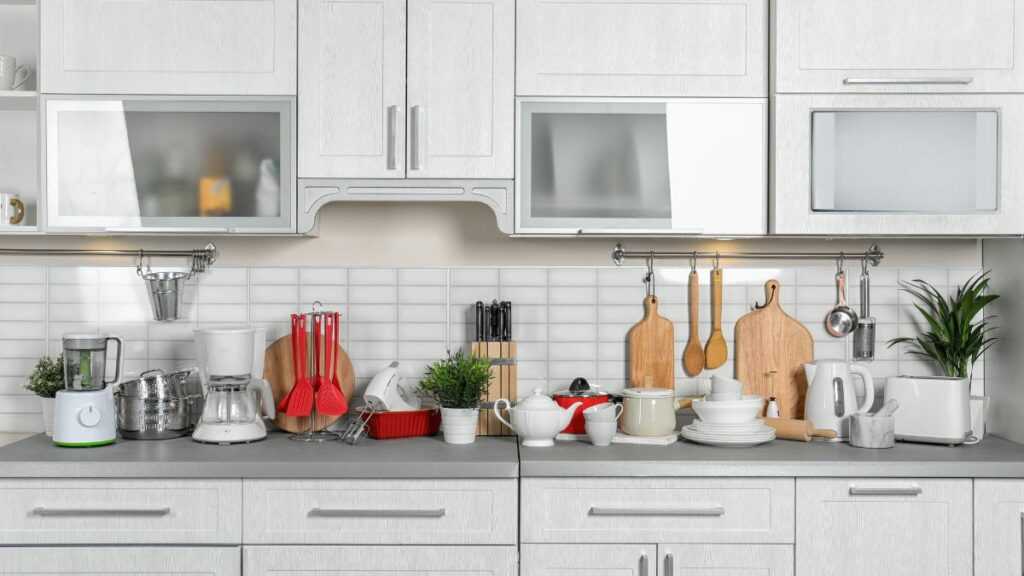Guilty of reaching for that microwave to prep most of your meals? Been there, grappled with that. It’s quite intriguing to discover microwaves actually use less energy than conventional cooking methods, making them a pocket-friendly and eco-friendlier option.
This post aims to demystify the pros and cons associated with our trusty little kitchen helper – from how it fares in nutrient retention, all the way to potential health repercussions.
So buckle up! We’re about to tackle whether or not its convenience truly tips the scale against any lurking downsides.
Key Takeaways
- Microwave cooking offers convenience and saves time, allowing you to cook food in minutes and have more free time for other activities.
- It is energy – efficient and has a lower environmental impact compared to traditional cooking methods, helping reduce your carbon footprint and save on utility bills.
- Microwave cooking is safe and reduces the risk of injury or damage, as there is no risk of fire and microwaves are designed with safety features like child locks.
- While concerns about taste, texture, and nutrient loss exist, microwave ovens are known to retain the nutritional value of ingredients and provide a convenient option for quick meals.
The Pros of Microwave Cooking

Microwave cooking offers numerous benefits, including convenience and time-saving advantages, energy efficiency and lower environmental impact, as well as improved safety and reduced risk of injury or damage.
Convenience and time-saving benefits
Using a microwave saves time. You can cook food in minutes. This is great if you are busy. Plus, it’s easy to use! Just set the cooking time and heat level. Then, press start and wait for your food to be ready.
It gives you more free time to do other things. No need to spend hours at the stove any more! Cooking with a microwave offers so much ease and comfort in our lives.
Energy efficiency and lower environmental impact
Microwave cooking offers energy efficiency and a lower environmental impact compared to traditional cooking methods. By using electromagnetic waves, microwaves transfer heat directly to the food, reducing the cooking time and energy consumption.
This makes them a more sustainable choice for individuals looking to minimize their carbon footprint and save on utility bills. In fact, studies have shown that microwave ovens use around 80% less energy than conventional ovens when heating or reheating small portions of food.
Additionally, since microwaves cook food faster, they release fewer greenhouse gas emissions during operation. So if you’re conscious about your energy consumption and want to reduce your environmental impact while still enjoying quick meals, microwave cooking is a great option for you!
Safety and reduced risk of injury or damage
Microwave cooking offers a safer option for preparing food compared to traditional ovens and stoves. With microwave ovens, there is no risk of fire, reducing the chances of injury or damage to your property.
This can bring peace of mind, especially for busy individuals who may need to multitask while cooking. Additionally, microwave ovens are designed with safety features such as child locks and automatic shut-off timers, further minimizing the risk of accidents.
So you can enjoy the convenience and time-saving benefits of microwave cooking without compromising on safety.
The Cons of Microwave Cooking
Microwave cooking does have some potential drawbacks, including concerns about the impact on taste and texture of food, worries about nutrient loss, and controversies surrounding health risks associated with microwave cooking.
Potential negative impact on taste and texture of food
Microwave cooking can sometimes have a negative impact on the taste and texture of food. Because microwaves cook food by emitting electromagnetic waves that heat up water molecules, certain types of foods may become soggy or lose their crispiness when cooked in a microwave.
For example, breads, pastries, and fried foods may end up being soft instead of crispy. Additionally, some people find that reheating leftovers in a microwave can result in uneven heating, making some parts of the food overly hot while others remain cold.
It’s important to note that not all types of dishes are affected in the same way – soups and stews tend to do well in microwaves because they retain their moisture better. However, if you’re looking for perfectly crispy or evenly heated food every time, other cooking methods like oven baking or stovetop cooking may be better options.
Concerns about nutrient loss
Some people worry that microwave cooking can cause a loss of nutrients in food. However, there is no evidence to support this claim. In fact, microwave ovens are known for their ability to retain the nutritional value of ingredients.
This is because they cook food quickly and at a lower temperature compared to other cooking methods. So you can still enjoy healthy and nutritious meals when using a microwave oven.
Controversies and health risks associated with microwave cooking
Some people have concerns about the controversies and health risks associated with microwave cooking. There are claims that microwaving food can be dangerous and may result in a loss of nutrients.
However, there is no evidence to support these beliefs. Microwave ovens are considered safe and effective for cooking, with no harm to health. In fact, one advantage of microwave cooking is its ability to retain the nutrients in food, as it cooks quickly at a lower temperature.
So, if you’re worried about potential risks or nutrient loss, rest assured that microwave cooking is a convenient and safe option.
Related Blogs and Different Perspectives
I found some interesting blogs that discuss the pros and cons of microwave cooking from different perspectives. One blog focuses on the convenience and time-saving benefits of microwave cooking, emphasizing how it can be a lifesaver for busy individuals or those with limited cooking skills.
Another blog explores the environmental impact of microwaves, highlighting their energy efficiency compared to traditional ovens and stoves. It also discusses some practical tips for using microwaves in an environmentally friendly way.
Additionally, I came across a blog that delves into controversies surrounding microwave cooking, such as concerns about nutrient loss and potential health risks associated with microwave radiation exposure.
These blogs offer different viewpoints on the subject, providing valuable insights for readers interested in understanding both sides of the argument.
Factors to Consider and Practical Tips for Microwave Cooking
When it comes to microwave cooking, there are several factors to consider and practical tips that can help you make the most out of this convenient method.
Cleaning and maintenance
Cleaning and maintaining your microwave oven is important to ensure its proper functioning and longevity. Here are some tips for keeping your microwave clean:
- Regularly wipe down the interior of the microwave with a damp cloth or sponge to remove any spills, splatters, or food particles.
- Use a mild dish soap or a mixture of vinegar and water to tackle stubborn stains or odors.
- Avoid using abrasive cleaners or scrub brushes that could scratch the interior surfaces of the microwave.
- Don’t forget to clean the exterior surfaces as well, including the control panel, door handle, and vents.
- Remove and wash the turntable, roller ring, and any other removable parts according to the manufacturer’s instructions.
- Pay attention to any built – up grease or debris in the ventilation system, as this can affect the performance of your microwave.
- Check and clean the seal around the door to ensure it creates an airtight seal when closed.
- Consider using a microwave cover or microwave – safe splatter guard when heating foods that have a tendency to splatter.
Choosing microwave-safe cookware

When using a microwave oven, it’s important to choose the right cookware to ensure safe and effective cooking. Here are some tips for selecting microwave-safe cookware:
- Look for cookware labeled as microwave – safe or specifically designed for use in the microwave. This ensures that the materials used can withstand the heat generated by microwaves without melting or releasing harmful chemicals.
- Avoid using metal or aluminum containers in the microwave, as they can cause sparks or fires. Opt for glass, ceramic, or microwave-safe plastic containers instead.
- Make sure your cookware is in good condition with no cracks, chips, or damage. Damaged cookware can release toxins into your food when exposed to microwaves.
- Use microwave – safe covers or lids to prevent splattering and retain moisture during cooking. These covers should be vented to allow steam to escape.
- Choose shallow containers for even and efficient cooking. The depth of the container affects how evenly heat is distributed throughout your food.
Using proper cooking techniques for best results
When cooking with a microwave, it’s important to use proper techniques to get the best results. Here are some tips:
- Stir and rotate: Stirring and rotating the food during cooking helps to ensure even heating and prevents any cold spots.
- Cover with a microwave-safe lid or wrap: If you’re reheating leftovers or cooking certain foods like vegetables or rice, covering them helps retain moisture and promote even cooking.
- Use microwave-safe cookware: Make sure you’re using dishes that are labeled as microwave-safe to prevent any potential hazards, such as melting or releasing harmful chemicals.
- Cut food into equal-sized pieces: When microwaving food, cutting it into equal-sized pieces helps to ensure that it cooks evenly.
- Follow recommended cooking times: Different foods require different cooking times in the microwave, so it’s important to follow the instructions provided or use recommended guidelines for specific foods.
- Allow for standing time: After microwaving, let your food stand for a few minutes before serving. This allows for more even heat distribution and can also help prevent burns from hot steam.
Final Verdict: Is Microwave Cooking Worth the Convenience?
In conclusion, microwave cooking offers undeniable convenience and time-saving benefits. It is a safe and efficient method of cooking that can save energy and reduce the risk of injury or damage.
While there are some concerns about taste, texture, and nutrient loss, overall, the advantages make microwave cooking worth considering for its convenience in our busy lives.
